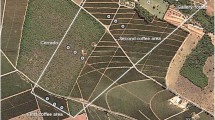Abstract
Studies on the prevalence ofHoplolaimus indicus, the lance nematode in rice fields revealed 4 distinct peaks of population viz., during the second fortnight of February, first fortnight of August and in the second fortnights of October and December during 1971–72. Average soil temperatures of 20·1° to 25·6°C at 5 cm depth were found optimum for the nematode activity. Low atmospheric temperatures of 22·1° to 23·2°C, high relative humidity (83 to 90%) and dew deposition on foliage were found to be conducive for the migration of the nematode from the soil to foliage of standing crops. The migratory behaviour was further confirmed in inoculations to soils with growing rice plants in pot cultures under green house conditions.
Similar content being viewed by others
References
Banerji S N and Banerji D K 1966 Occurrence of the nematodeHoplolaimus indicus in West Bengal;Curr. Sci 35 597–598
Birat R B S 1965 New records of parasitic nematodes on rice (Oryza sativa L) in Bihar;Sci. Cult 31 494
Das P K and Rao Y S 1970 Life history and pathogenesis ofHoplolaimus indicus in rice;Indian Phytopathol 23 459–464
Gupta J C and Atwal A S 1971 Biology and ecology ofHopolaimus indicus (Hoplolaimidae: Nematoda) II. The influence of various environmental factors and host plants on the reproductive potential;Nematologica 17 277–284
Khan AM, Adhami A and Saxena S K 1971 Population changes of some stylet bearing nematodes associated with mango (Magnifera indica L);Indian J. Nematol 1 99–104
Nandakumar C and Rao Y S 1974 On the migratory behaviour of some subterranean nematodes to aerial parts of rice plants;Nematologica 20 106
Radewald J D, O’Bannon J H and Tomerlin A T 1971 Anatomical studies ofCitrus jambhiri roots infected byPratylenchus coffeae J. Nematol 3 409–416
Ramana K V 1969 Varietal reaction and survival ofHoplolaimus indicus Sher 1963 in relation to pathogenesis on ragi (E1eusine coracana Gaert). M.Sc Thesis Orissa Univ. Agric. & Tech. Bhubaneswar
Rao Y S 1970 Study of plant parasitic nematodes affecting rice production in the vicinity of Cuttack (Orissa) India US PL 480 Proj. Final Tech. Rep. (Memiogr) Central Rice Research Institute Cuttack.
Author information
Authors and Affiliations
Rights and permissions
About this article
Cite this article
Ramana, K.V., Prasad, J.S. & Seshagiri Rao, Y. Influence of atmospheric conditions and soil temperature on the prevalence of the lance nematode (Hoplolaimus indicus Sher, 1963) in rice fields. Proc. Indian Acad. Sci (Animal Sciences) 87, 39–43 (1978). https://doi.org/10.1007/BF03178999
Received:
Issue Date:
DOI: https://doi.org/10.1007/BF03178999




